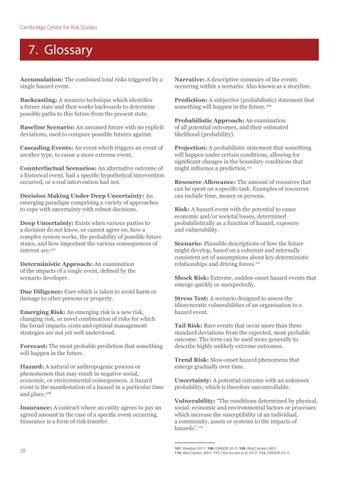Cambridge Centre for Risk Studies
7. Glossary Accumulation: The combined total risks triggered by a single hazard event.
Narrative: A descriptive summary of the events occurring within a scenario. Also known as a storyline.
Backcasting: A scenario technique which identifies a future state and then works backwards to determine possible paths to this future from the present state.
Prediction: A subjective (probabilistic) statement that something will happen in the future.109
Baseline Scenario: An assumed future with no explicit deviations, used to compare possible futures against. Cascading Events: An event which triggers an event of another type, to cause a more extreme event. Counterfactual Scenarios: An alternative outcome of a historical event, had a specific hypothetical intervention occurred, or a real intervention had not. Decision Making Under Deep Uncertainty: An emerging paradigm comprising a variety of approaches to cope with uncertainty with robust decisions. Deep Uncertainty: Exists when various parties to a decision do not know, or cannot agree on, how a complex system works, the probability of possible future states, and how important the various consequences of interest are.107 Deterministic Approach: An examination of the impacts of a single event, defined by the scenario developer. Due Diligence: Care which is taken to avoid harm or damage to other persons or property. Emerging Risk: An emerging risk is a new risk, changing risk, or novel combination of risks for which the broad impacts, costs and optimal management strategies are not yet well understood. Forecast: The most probable prediction that something will happen in the future. Hazard: A natural or anthropogenic process or phenomenon that may result in negative social, economic, or environmental consequences. A hazard event is the manifestation of a hazard in a particular time and place.108
Probabilistic Approach: An examination of all potential outcomes, and their estimated likelihood (probability). Projection: A probabilistic statement that something will happen under certain conditions, allowing for significant changes in the boundary conditions that might influence a prediction.110 Resource Allowance: The amount of resources that can be spent on a specific task. Examples of resources can include time, money or persons. Risk: A hazard event with the potential to cause economic and/or societal losses, determined probabilistically as a function of hazard, exposure and vulnerability. Scenario: Plausible descriptions of how the future might develop, based on a coherent and internally consistent set of assumptions about key deterministic relationships and driving forces.111 Shock Risk: Extreme, sudden-onset hazard events that emerge quickly or unexpectedly. Stress Test: A scenario designed to assess the idiosyncratic vulnerabilities of an organisation to a hazard event. Tail Risk: Rare events that occur more than three standard deviations from the expected, most probable outcome. The term can be used more generally to describe highly unlikely extreme outcomes. Trend Risk: Slow-onset hazard phenomena that emerge gradually over time. Uncertainty: A potential outcome with an unknown probability, which is therefore uncontrollable.
Insurance: A contract where an entity agrees to pay an agreed amount in the case of a specific event occurring. Insurance is a form of risk transfer.
Vulnerability: “The conditions determined by physical, social, economic and environmental factors or processes which increase the susceptibility of an individual, a community, assets or systems to the impacts of hazards”.112
38
107. (Kwakkel 2017) 108. (UNISDR 2017) 109. (MacCracken 2001) 110. (MacCracken 2001) 111. (Van Vuuren et al. 2012) 112. (UNISDR 2017)
